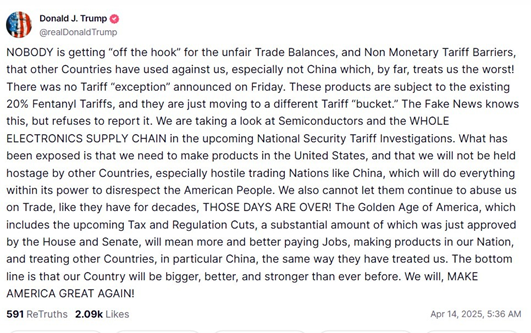On Sunday night, US president, Donald Trump, addressed his own social networks application, social truth, and clarified that there will be no exemption from tariffs on semiconductors and the electronics supply chain, since these products will be subject to existing tariffs of 20% over the fentanyl and not to the increase of 145%.

This occurs after the US Customs and Border Protection Office issued a guide on Friday night indicating that certain items such as smartphones, laptops, hard drives, flat screen monitors, semiconductors, etc., would be exempt from both the basic reciprocal tariffs of 10% of Trump and of the tariffs of 145% on Chinese imports.
However, US Secretary of Commerce, Howard Lutnick, said in an interview with ABC News on Sunday that smartphones, computers and some other electronic devices, which have just been exempt from high tariffs on imports from China, will face new separate taxes together with semiconductors in the next two months.
Lutnick added that “he is not worried about the US dollar.”
Meanwhile, US trade representative (USTR), Jamieson Greer, told CBS News on Sunday that President Trump and Chinese President Xi Jinping “have no plans” to speak in the midst of an escalation of the commercial war between the two countries.
“We have to be much more deliberate about the semiconductor supply chain,” he said about the latest tariff conversations about electronics and semiconductors.
Market reaction
In the midst of news about tariffs not so high to Chinese imports of the electronic supply chain, the feeling of risk is at a sweetest point at the beginning of the new week, early on Monday, with the index of the US dollar keeping the warm recovery from minimum of three years.
Commercial War between the US and China Faqs
In general terms, “Trade War” is a commercial war, an economic conflict between two or more countries due to the extreme protectionism of one of the parties. It implies the creation of commercial barriers, such as tariffs, which are in counterbarreras, increasing import costs and, therefore, the cost of life.
An economic conflict between the United States (USA) and China began in early 2018, when President Donald Trump established commercial barriers against China, claiming unfair commercial practices and theft of intellectual property by the Asian giant. China took retaliation measures, imposing tariffs on multiple American products, such as cars and soybeans. The tensions climbed until the two countries signed the Phase one trade agreement between the US and China in January 2020. The agreement required structural reforms and other changes in China’s economic and commercial regime and intended to restore stability and confidence between the two nations. Coronavirus pandemia diverted the attention of the conflict. However, it is worth mentioning that President Joe Biden, who took office after Trump, kept the tariffs and even added some additional encumbrances.
Donald Trump’s return to the White House as the 47th US president has unleashed a new wave of tensions between the two countries. During the 2024 election campaign, Trump promised to impose 60% tariff particularly in investment, and directly feeding the inflation of the consumer price index.
Source: Fx Street
I am Joshua Winder, a senior-level journalist and editor at World Stock Market. I specialize in covering news related to the stock market and economic trends. With more than 8 years of experience in this field, I have become an expert in financial reporting.







